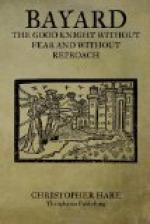When all was ready on the appointed day for the tournament at Aire, the trumpet sounded, and then the order of the Tourney was declared aloud. Bayard had to appear first in the lists, and against him rode forth a neighbour of his in Dauphine, by name Tartarin, a powerful man-at-arms. They rushed at each other so vehemently that Tartarin broke his lance half a foot from the iron, and Bayard struck him above the arm-piece of his armour and broke his lance into five or six pieces, upon which the trumpets sounded forth triumphantly, for the joust was wonderfully good. After having finished their first attack they returned to face each other for the second. Such was the fortune of Tartarin that with his lance he forced in Bayard’s arm-piece, and every one thought that he had his arm pierced. But he was not hurt, and succeeded in returning the attack by a stroke above the visor, which carried off the bunch of plumes from his adversary’s helmet. The third bout with the lance was as good or even better than the others, for the lance was more completely shivered into fragments.
When these two knights had finished, next came the lord of Bellabre, and against him a Scotch man-at-arms, named the Captain David of Fougas, and these likewise did with their three jousts of the lance all that it was possible for gentlemen to do. Thus, two by two, all the company went through the same contest.
This jousting with the lance was one of the most popular exercises for knights of that day, and the proper use of this weapon was one of the most important accomplishments for a warrior. We shall often notice, in the accounts of Bayard’s adventures on the field of battle, how extremely expert he was with his lance. The supreme triumph with this weapon was to use such skill and force as to break the lance shaft—made of ash or sycamore—into as many pieces as possible; in fact, to “shiver” it completely, and thus break as many lances as possible. The tilting lance was often made hollow, and was from 12 to 15 feet long; but the lance used with the object of unhorsing instead of splintering was much stronger, heavier, and thicker in the stem, and instead of a pointed head had a “coronal,” which was blunt.
The first part of the tournament having come to an end, then followed the battle of the swords. According to the rules, this began with Bayard, who, on the third stroke he gave, broke his sword into two pieces, but he made such good use of the stump that he went through the number of strokes commanded, and did his duty so well that no man could have done better. After this came the others according to their order, and for the rest of that day there was such a succession of vigorous fighting that the two judges declared “never had there been finer lance work or contests with the sword.” When the evening came they retired to young Bayard’s lodging, where a great supper was prepared, to which came many ladies, for within ten miles round all those of Picardy, or the greater number, had come to see this fine tournament. After the supper there were dances and other entertainments, and the company was so well amused that it struck one hour after midnight before they broke up. It was late next morning before they woke up, and you may believe that they were never weary of praising Messire de Bayard, as much for his skill at arms as for his good hospitality.




